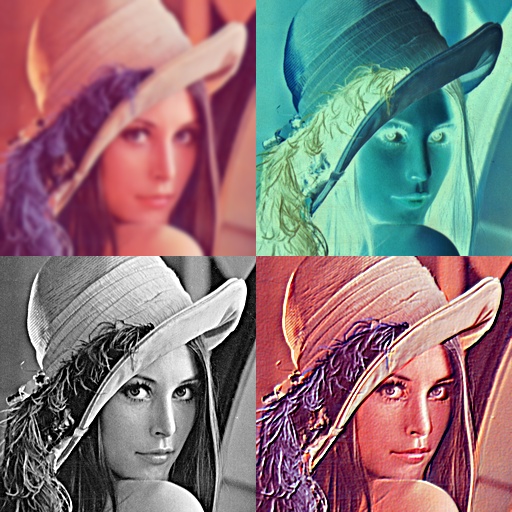Imaging
Package imaging provides basic image manipulation functions (resize, rotate, flip, crop, etc.). This package is based on the standard Go image package and works best along with it.
Image manipulation functions provided by the package take any image type
that implements image.Image interface as an input, and return a new image of
*image.NRGBA type (32bit RGBA colors, not premultiplied by alpha).
Installation
Imaging requires Go version 1.2 or greater.
go get -u github.com/disintegration/imaging
Documentation
http://godoc.org/github.com/disintegration/imaging
Usage examples
A few usage examples can be found below. See the documentation for the full list of supported functions.
Image resizing
// Resize srcImage to size = 128x128px using the Lanczos filter.
dstImage128 := imaging.Resize(srcImage, 128, 128, imaging.Lanczos)
// Resize srcImage to width = 800px preserving the aspect ratio.
dstImage800 := imaging.Resize(srcImage, 800, 0, imaging.Lanczos)
// Scale down srcImage to fit the 800x600px bounding box.
dstImageFit := imaging.Fit(srcImage, 800, 600, imaging.Lanczos)
// Resize and crop the srcImage to fill the 100x100px area.
dstImageFill := imaging.Fill(srcImage, 100, 100, imaging.Center, imaging.Lanczos)Imaging supports image resizing using various resampling filters. The most notable ones:
NearestNeighbor- Fastest resampling filter, no antialiasing.Box- Simple and fast averaging filter appropriate for downscaling. When upscaling it's similar to NearestNeighbor.Linear- Bilinear filter, smooth and reasonably fast.MitchellNetravali- А smooth bicubic filter.CatmullRom- A sharp bicubic filter.Gaussian- Blurring filter that uses gaussian function, useful for noise removal.Lanczos- High-quality resampling filter for photographic images yielding sharp results, but it's slower than cubic filters.
The full list of supported filters: NearestNeighbor, Box, Linear, Hermite, MitchellNetravali, CatmullRom, BSpline, Gaussian, Lanczos, Hann, Hamming, Blackman, Bartlett, Welch, Cosine. Custom filters can be created using ResampleFilter struct.
Resampling filters comparison
The original image.
The same image resized from 512x512px to 128x128px using different resampling filters. From faster (lower quality) to slower (higher quality):
| Filter | Resize result |
|---|---|
imaging.NearestNeighbor |
 |
imaging.Linear |
 |
imaging.CatmullRom |
 |
imaging.Lanczos |
 |
Gaussian Blur
dstImage := imaging.Blur(srcImage, 0.5)Sigma parameter allows to control the strength of the blurring effect.
| Original image | Sigma = 0.5 | Sigma = 1.5 |
|---|---|---|
 |
 |
 |
Sharpening
dstImage := imaging.Sharpen(srcImage, 0.5)Sharpen uses gaussian function internally. Sigma parameter allows to control the strength of the sharpening effect.
| Original image | Sigma = 0.5 | Sigma = 1.5 |
|---|---|---|
 |
 |
 |
Gamma correction
dstImage := imaging.AdjustGamma(srcImage, 0.75)| Original image | Gamma = 0.75 | Gamma = 1.25 |
|---|---|---|
 |
 |
 |
Contrast adjustment
dstImage := imaging.AdjustContrast(srcImage, 20)| Original image | Contrast = 10 | Contrast = -10 |
|---|---|---|
 |
 |
 |
Brightness adjustment
dstImage := imaging.AdjustBrightness(srcImage, 20)| Original image | Brightness = 10 | Brightness = -10 |
|---|---|---|
 |
 |
 |
Example code
package main
import (
"image"
"image/color"
"log"
"github.com/disintegration/imaging"
)
func main() {
// Open the test image.
src, err := imaging.Open("testdata/lena_512.png")
if err != nil {
log.Fatalf("Open failed: %v", err)
}
// Crop the original image to 350x350px size using the center anchor.
src = imaging.CropAnchor(src, 350, 350, imaging.Center)
// Resize the cropped image to width = 256px preserving the aspect ratio.
src = imaging.Resize(src, 256, 0, imaging.Lanczos)
// Create a blurred version of the image.
img1 := imaging.Blur(src, 2)
// Create a grayscale version of the image with higher contrast and sharpness.
img2 := imaging.Grayscale(src)
img2 = imaging.AdjustContrast(img2, 20)
img2 = imaging.Sharpen(img2, 2)
// Create an inverted version of the image.
img3 := imaging.Invert(src)
// Create an embossed version of the image using a convolution filter.
img4 := imaging.Convolve3x3(
src,
[9]float64{
-1, -1, 0,
-1, 1, 1,
0, 1, 1,
},
nil,
)
// Create a new image and paste the four produced images into it.
dst := imaging.New(512, 512, color.NRGBA{0, 0, 0, 0})
dst = imaging.Paste(dst, img1, image.Pt(0, 0))
dst = imaging.Paste(dst, img2, image.Pt(0, 256))
dst = imaging.Paste(dst, img3, image.Pt(256, 0))
dst = imaging.Paste(dst, img4, image.Pt(256, 256))
// Save the resulting image using JPEG format.
err = imaging.Save(dst, "testdata/out_example.jpg")
if err != nil {
log.Fatalf("Save failed: %v", err)
}
}Output:

